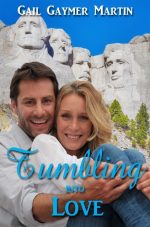by Gail Gaymer Martin
When writers search for plot ideas, seasoned authors often respond write what you know, but I’ve found that this phrase means more than I’d thought. If we stick with what we know, our books could become boring, but one way to write what I know is through experiences. I’ve done this more than once. Being a horrible golfer, I created a humorous scene using the heroine and golf outing to show her ineptness in front of people she wanted to impress, but I exaggerated this scene to be worse than I am…which is bad enough. But one of my new releases uses the experience technique to the fullest and with accuracy.

A number of years ago, I was involved in a frightening accident that could have been fatal. Instead we came away with scratches and bruises and gratefulness that things happened as they did. When I was participating in a book collection called National Parks, this true experience came to mind and I sent my thoughts back to the frightening experience, digging out details and used it as a main thread in the novella, Tumbling Into Love. In fact I not only used the one experience but recalled numerous other events that had happened on that trip and I used them especially for comic relief.
Life offers us all kinds of experiences that broaden our knowledge, but when we dig into our past, these are often things that wanted to know but ones we were forced to know. Think back in your lifetime and make a list of experiences that you’ve had, both bad and good. Is the experience something you could use as the book’s opening or to add a dark moment, or could it add a bit of levity, which I enjoy doing. Shakespeare knew that his darkest plays needed a break. In Hamlet, he included a scene with drunken the grave diggers. In Macbeth, it’s the scene with the Porter who answers the door which he refers to as hell’s door with the line, “Knock, Knock. Who’s there?” In Romeo and Juliet, the comic relief comes from the Nurse and her scene with Mercutio.
Because you’re writing fiction, the event that you use doesn’t have to be detail for detail. You can broaden or worsen the situation to make it work for your particular story and for the reason you have chosen to use it. Is it for excitement, danger, or humor? I chose the accident scene in Tumbling Into Love, to not only bring the two major characters together but to set the stage for much of the events that happen later in the story.
From now on when you hear “Write What You Know,” remember that you can use the knowledge from your career, your lifestyle, your upbringing, your hobbies and talents, but you can also add the twist of what you know by digging out an experience that can serve you in a positive way to make your plot or characterization even better.

Multi-award-winner and bestselling novelist, Gail Gaymer Martin has 76 published novels with over 4 million books sold. Gail is the author of Writers Digest, Writing the Christian Romance and founder of American Christian Fiction Writers. Gail was a counselor and university instructor in Michigan. She now lives in Sedona. AZ.

Comments 0
Gail, this makes perfect sense to me. I find that tapping my deepest emotions works in developing characters. Emotions are transferable. The hero in my WIP is a man (obviously), a former California boy and surfer, and a church pastor. I am none of those things, but…I have incidents in my past of verbal abuse and “not good enough,” and I transferred them over to him as part of his character arc. The heroine and I have nothing in common on the surface, but I dug deep into myself for her control-freak tendencies. We mine our experiences and come up with ore.
Kathy Bailey